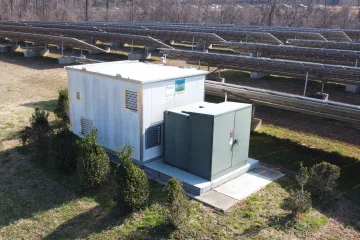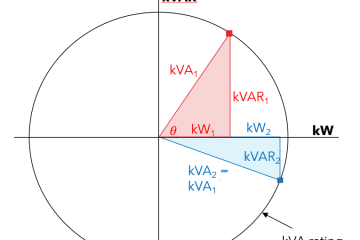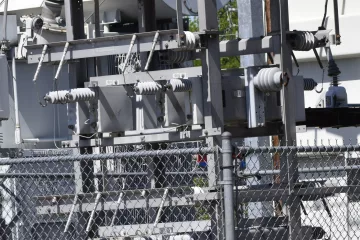This is the fourth of five articles in the series “Reactive Power in Utility-Scale Solar PV Applications.”
In the earlier articles in this series, we’ve looked at the purpose of reactive power, power ratings of utility-scale solar inverters, and how real power, reactive power, and apparent power are interrelated.
In this article, we’re going to focus on the right side of Figure 1 which looks a bit like a side view of one of Dr. T.J. Eckleburg’s eyes. (Literary reference, for those who were paying attention in high school English. Explanation at the end of this article).
Active Power Priority and Reactive Power Priority
Modern inverters can produce reactive power and real power independently of each other unless the inverter is operating at its kVA limit. The question we’re addressing is when the inverter is operating at its kVA limit (Srated in Figure 1), and then a need to increase kW or kVAr production arises.
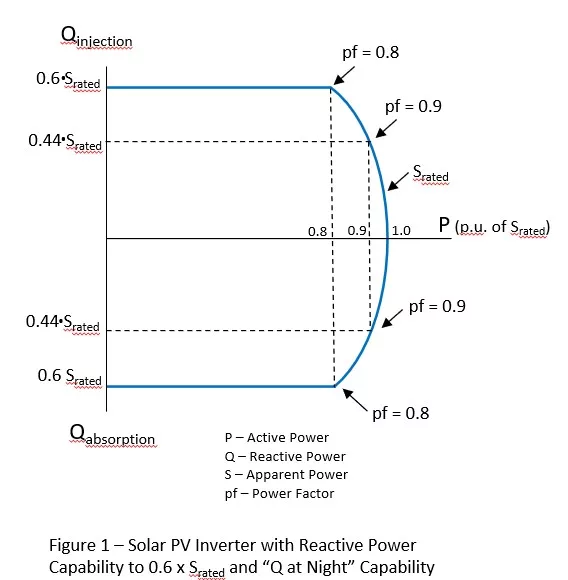
The need for increased real or reactive power production may be during steady-state conditions or during or following a system contingency. The request could be a result of the inverter’s reactive power control, a control signal from a plant controller or the control center, or increased availability of the solar resource with a resulting increase in DC power to the inverter.
Let’s look at Figure 2 below. Let’s assume our inverter is operating at kW1 and kVAr1. This results in operation at the red square on the kVA rating curve. Now let’s assume that the transmission or distribution operator, or the inverter’s reactive power control algorithm, requests the inverter to produce more kVAR, to a level represented by kVAr2. Since the inverter is already maxed to its kVA rating, there are two options.
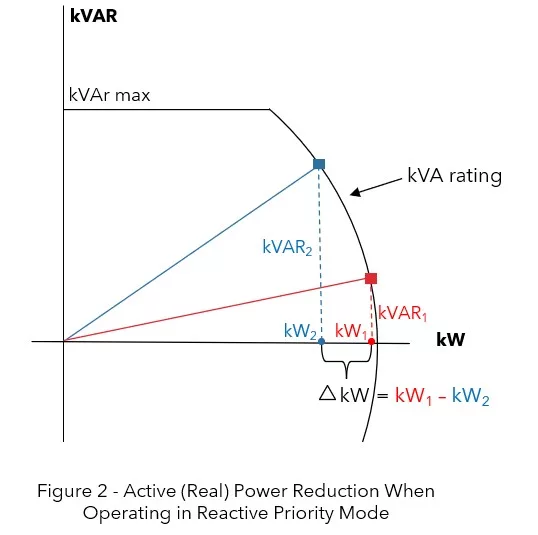
Second option: if the inverter is operating in “Reactive Power Priority” mode, then reactive power (kVAr) requests take precedence over kW. Since at the red square the inverter is already operating at its kVA rating, the only option to produce additional kVAr and reach kVAr2 is to reduce active power production to kW2. The good thing is that the requested number of kVAr is now being produced. The tradeoff is the revenue-producing kW has been reduced by an amount equal to kW1 – kW2.
Keep in mind that this only happens when the inverter is already operating at or near its kVA rating. In many cases with Solar PV facilities, this is usually quite a small amount of time. However, it can be common for a Solar PV plant to reach peak production while the system requires more VArs. In those cases, operation in reactive power priority mode can contribute to system stability during disturbances by providing reactive power to the system when it is most needed.
A similar situation can also arise if your inverter is operating at its kVA rating at unity power factor (0 kVAr) and the system operator asks you to adjust your inverter to operate at a non-unity power factor (say, 0.96). You’ll have to give up some kW at peak time to be able to produce the required kVAr and reduce power factor to that value.
IEEE 1547-2018TM
IEEE 1547-2018, which more US states are adopting for distribution interconnection requirements, specifies that DER be capable of Reactive Power Priority. At any operating point above 20% of rated active power, reactive power injection or absorption shall not constrain the delivery of reactive power up to certain limits. Further details can be found in Clause 5.2 of the standard.
If you’re a Solar PV developer or owner, it’s prudent to see if your system operator mandates “Reactive Power Priority” and size the inverters accordingly.
(Answer to the literary reference mentioned earlier, if you haven’t Googled it yet: F. Scott Fitzgerald’s The Great Gatsby!)
Tim Taylor is the founder of Electric Distribution Academy, and all his courses are hosted exclusively on HeatSpring. Tim is the instructor for several courses focused on utility distribution, including “Interconnection of Utility-Scale Solar PV to Distribution” and “Understanding IEEE 1547-2018 – Interconnection Standard for DER on Distribution.
